Content for TS 23.280 Word version: 19.5.0
1…
5…
6
7…
8…
9…
10…
10.1.5…
10.2…
10.2.6…
10.3…
10.6…
10.7…
10.7.3.8…
10.8…
10.9…
10.9.3.9…
10.10…
10.10.3
10.11…
10.12…
10.13…
10.14…
10.15…
10.16…
10.17…
10.18…
10.19…
11…
11.5…
A…
B…
C…
E…
10.11 MC service resource management (on-network)
10.11.1 General
10.11.2 Request for unicast resources at session establishment - SIP core based
10.11.2a Request for unicast resources at session establishment - MC service server based
10.11.3 Request for modification of unicast resources
10.11.4 Management of multicast media bearers
10.11.5 Request for resources with shared priority
10.11.6 Request for media resources from MC service server
...
...
10.11 MC service resource management (on-network) |R15| p. 270
10.11.1 General p. 270
The following subclauses specify the procedures for resource management for mission critical services. The procedures are utilised by the following MC services:
- MCPTT (as specified in TS 23.379);
- MCVideo (as specified in TS 23.281); and
- MCData (as specified in TS 23.282).
- activation and deactivation of the bearer;
- modification of the QoS characteristics of the bearer (e.g. bearer priority adjustment); and
- modification of GBR due to media codec change
10.11.2 Request for unicast resources at session establishment - SIP core based p. 271
The procedure defined in this subclause specifies how network resources are requested at session establishment. If concurrent sessions are used the MC service server may utilize the capability of resource sharing specified in TS 23.203. The request for resources is sent to the PCRF on the Rx reference point and includes media type, bandwidth, priority, application identifier and resource sharing information.
The procedure is generic to any type of session establishment that requires requests for network resources.
Procedures in Figure 10.11.2-1 are the signalling procedures for the requesting resource at session establishment.
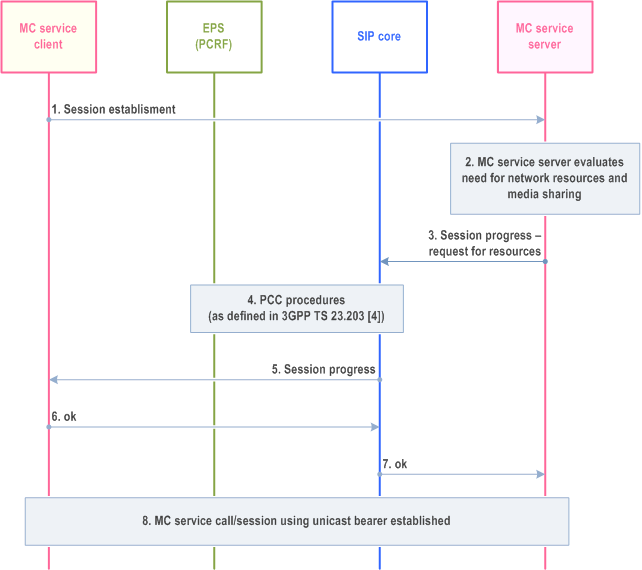
Step 1.
MC service client sends a session establishment request.
Step 2.
MC service server evaluates the need for network resources and the use of media resource sharing.
Step 3.
MC service server send a session progress request containing request for resources.
Step 4.
PCC procedures (as defined in TS 23.203) initiated from SIP core local inbound/outbound proxy over Rx.
Step 5.
The SIP core local inbound / outbound proxy forwards the call control protocol request to the MC service client.
Step 6.
The MC service client acknowledges the session progress request with an OK message.
Step 7.
The SIP core local inbound / outbound proxy forwards the OK message to the MC service server.
Step 8.
The MC service session is established and resources have been allocated.
10.11.2a Request for unicast resources at session establishment - MC service server based |R17| p. 272
10.11.2a.1 General p. 272
The procedure defined in this clause specifies how network resources are requested at session establishment from the MC service server. The request for resources is sent to the PCRF via the Rx reference point from the MC service server and includes media type, bandwidth, priority, application identifier and resource sharing information. If concurrent sessions are used, the MC service server may utilize the capability of resource sharing specified in TS 23.203.
For the request of network resources by the MC service server via the Rx reference point, the MC service client provides to the MC service server the final access resource details (e.g. IP addresses and ports) of the MC service client and the media anchoring points.
This procedure is generic to any type of session establishment with the MC service server requesting network resources.
10.11.2a.2 Procedure p. 272
Figure 10.11.2a.2-1 describes the procedure for the request of resources at session establishment from the MC service server.
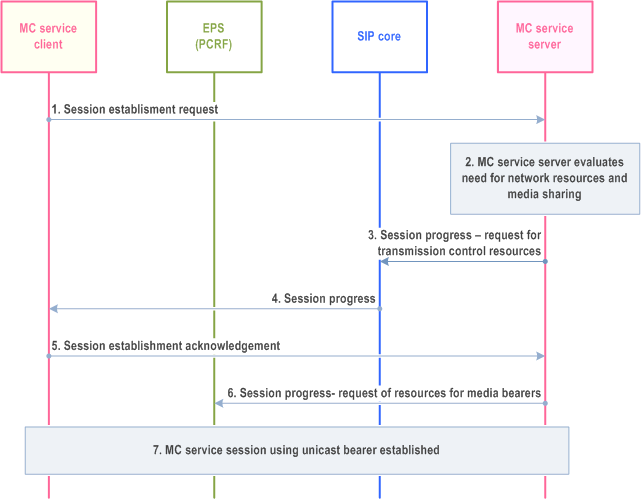
Step 1.
The MC service client sends a session establishment request. The request includes, apart from the SDP offer, access resource details, e.g. IP addresses and ports of the MC service client related to the media session.
Step 2.
The MC service server evaluates the need of network resources and use of media resource sharing.
Step 3.
The MC service server sends a session progress request to the SIP core.
Step 4.
The SIP core local inbound / outbound proxy forwards the session progress request to the MC service client.
Step 5.
The MC service client acknowledges the session establishment to the MC service server. This message contains the final negotiated media access parameters, e.g. IP addresses and ports related to the media anchoring points received in the SDP answer from the SIP core.
Step 6.
The MC service server sends a request for media resources to the PCRF over Rx (as defined in TS 23.203).
Step 7.
The MC service session is established, and resources have been allocated.
10.11.3 Request for modification of unicast resources p. 273
To modify unicast media bearers, the MC service server shall send a resource modification request containing the parameters to be modified, using the call control protocol via the SIP core to the UE.
Possible scenarios when this procedure may be used are:
- Modify the allocation and retention priority for unicast resources;
- Release and resume resources in-between MC service calls when using the chat model; or
- Release and resume resources when a UE is able to receive the MC service call over multicast transmission
- An MC service session is already in progress;
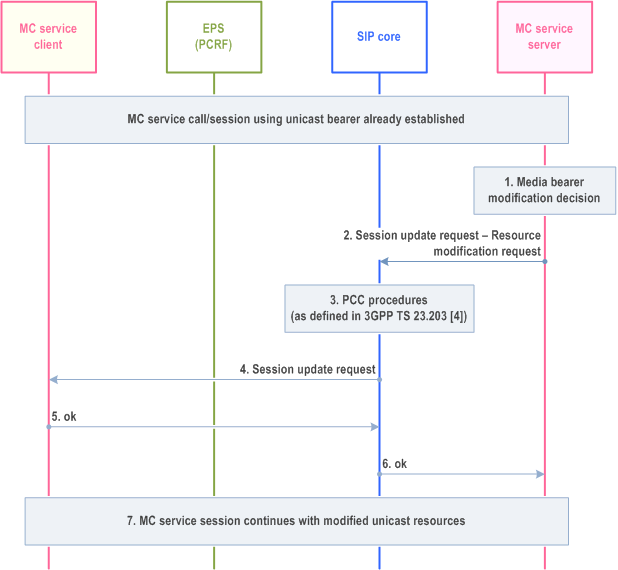
Step 1.
MC service server decides to modify the parameters of a unicast bearer (e.g. a request to upgrade the existing MC service call to an MC service emergency or imminent-peril call).
Step 2.
MC service server sends a session update which includes a resource modification request containing the modified parameters of the unicast bearer.
Step 3.
PCC procedures (as defined in TS 23.203) initiated from SIP core local inbound/outbound proxy over Rx.
Step 4.
The SIP core local inbound / outbound proxy forwards the session update request to the MC service client.
Step 5.
The MC service client acknowledges the call control protocol request with an OK message.
Step 6.
The SIP core local inbound / outbound proxy forwards the OK message to the MC service server.
Step 7.
The MC service session continues with the modified unicast resources.
10.11.4 Management of multicast media bearers p. 274
To activate the multicast media bearers the MC service server shall use the Activate MBMS Bearer procedure specified in TS 23.468 with the MC service server performing the GCS AS function. The MC service server shall activate MBMS bearers in broadcast areas where eMBMS capable UEs are or are expected to be located. For that, the MC service server shall use the MBMS SAI(s) and/or cell id(s) information to construct the MBMS broadcast area parameter in the Activate MBMS Bearer procedure.
To deactivate the multicast media bearers the MC service server shall use the Deactivate MBMS Bearer procedure specified in TS 23.468 with the MC service server performing the GCS AS function.
To modify multicast media bearers the MC service server shall use the Modify MBMS Bearer procedure specified in TS 23.468 with the MC service server performing the GCS AS function.
10.11.5 Request for resources with shared priority p. 275
10.11.5.1 General p. 275
An MC service server that supports simultaneous sessions may need to share a common priority on the EPS bearer for several MC service group calls that may use different priorities on the application level. This is achieved by including information for priority sharing on the request of resources over Rx reference point to PCRF. All sessions associated with the same priority sharing information will be handled by one EPS bearer, which will have a priority based on the highest requested priority among the sessions.
The use of the procedure defined in subclause 10.11.5.2 is dependent on operator policy.
10.11.5.2 Procedure p. 275
Pre-conditions:
- All previous resource requests from the MC service have included a priority sharing information.
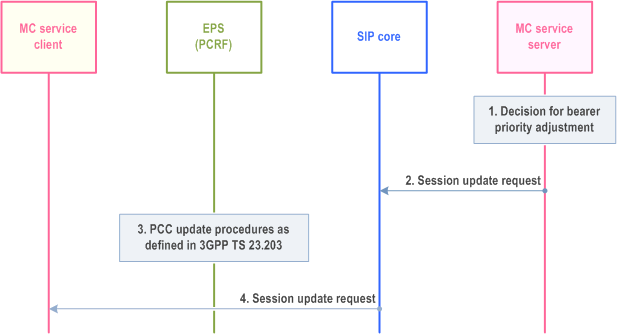
Step 1.
The MC service server decides based on a request from the MC service client that the priority of an ongoing call must be adjusted.
Step 2.
The MC service server requests a session update to the SIP core. This request will contain information of priority sharing.
Step 3.
PCC update procedures (as defined in TS 23.203) initiated from SIP core local inbound/outbound proxy over Rx. PCC updates the bearer priority for the bearer that contains the SDFs associated with the same priority sharing information. The priority is set to highest priority (lowest ARP) among those SDFs. No additional bearer is created. Also, the default bearer priority is updated accordingly.
Step 4.
The session update is forwarded to the MC service client.
10.11.6 Request for media resources from MC service server p. 276
10.11.6.1 General p. 276
The procedure in this sub clause specify how request for resource for floor control (or transmission control in MCVideo and MCData) and for the media plane can be handled independently. This procedure utilizes the Rx reference point both between from the MC service server to the PCRF and from the SIP core to the PCRF.
Resource for the transmission control is requested at session establishment, in this case the IMS standard procedures as specified in TS 23.228 are used. The session description shall in this procedure include bandwidth information applicable for the transmission control traffic requirement. At group call setup the request for resources for the media plane is triggered. This request is sent directly from the MC service server to the PCRF.
The procedure is optional and is suitable when the procedures for pre-established sessions are used, it may also be used to setup and tear down the media plane used by between consecutive group calls in one communication session using the chat call model.
10.11.6.2 Procedure p. 276
The Figure below illustrates the procedure for resource reservation.
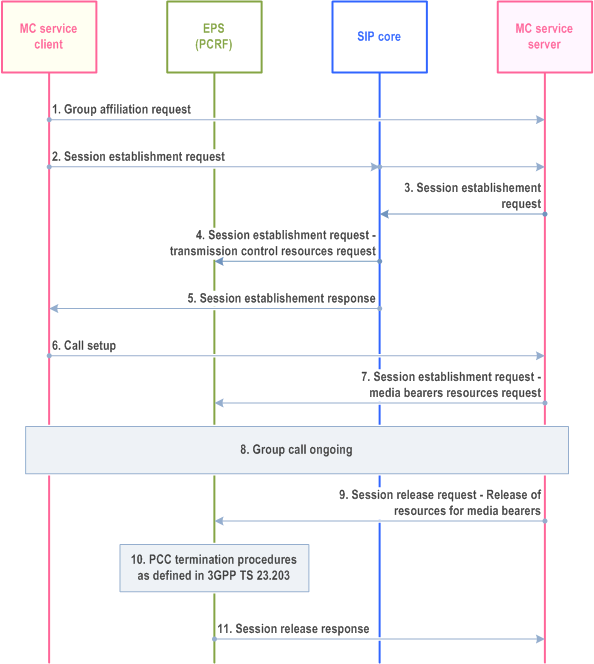
Step 1.
The MC service client sends a request for group affiliation.
Step 2.
The MC service client sends a request to the MC service server for establishment of a communication session.
Step 3.
The MC service server answers the session establishment request and adjusts the bandwidth information in the session description. The requested bandwidth shall be minimized to cover the bandwidth requirements for floor control signalling (or transmission control for MCVideo or MCData).
Step 4.
The SIP core request resources towards the PCRF according to the session establishment request.
Step 5.
The session establishment request is completed and a response is sent towards the MC service client.
Step 6.
The MC service client sends a call setup message according to existing procedures.
Step 7.
The MC service server sends a session establishment request for resources for the media plane to PCRF, and the media plane is by that established. This request includes media description relevant for the media plane.
Step 8.
Group call is ongoing on the group communication session.
Step 9.
The MC service serve sends a release of media resources to PCRF, and the media plane is by that terminated.
Step 10.
The PCRF performs session termination procedure according to TS 23.203.
Step 11.
The PCRF sends a session release response back to the MC service server.